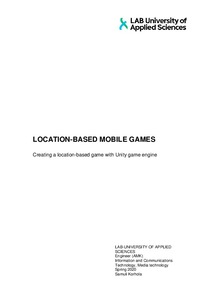Viability of business models in the gaming industry
Zeroukhi, Abderrahmane (2022)
Zeroukhi, Abderrahmane
2022
Julkaisun pysyvä osoite on
https://urn.fi/URN:NBN:fi:amk-2022120225769
https://urn.fi/URN:NBN:fi:amk-2022120225769
Tiivistelmä
Technological advancements and innovation lead to new methods in offering value to customers. The gaming industry applies innovative methods to already established ones, creating a pool of choices when providing a value offer. This research aimed to analyse business models to evaluate their characteristics, benefits, and downsides to define which model would be sustainable for the future.
The research done in this thesis is of explorative and qualitative nature, aided by utilization of the business model canvas and SWOT analysis. The BMC analysis determines the features of each model while the SWOT analysis supports the findings to reach the goal of the research.
Analysing the approaches of the business models showcases the differences between them. The type of value offer and the chosen distribution channels require partnering with external parties, which affects the budgeted costs. Determining the strengths and weakness of those choices, paired with the assessment of external threats and opportunities are key elements to be considered when reaching the decision on the business model.
The thesis concludes that the physical model is not optimised with the trends of the gaming industry, while the free-to-play model has many similarities to the digital and subscription models but with more threats and weaknesses. The digital and subscription models are the
The research done in this thesis is of explorative and qualitative nature, aided by utilization of the business model canvas and SWOT analysis. The BMC analysis determines the features of each model while the SWOT analysis supports the findings to reach the goal of the research.
Analysing the approaches of the business models showcases the differences between them. The type of value offer and the chosen distribution channels require partnering with external parties, which affects the budgeted costs. Determining the strengths and weakness of those choices, paired with the assessment of external threats and opportunities are key elements to be considered when reaching the decision on the business model.
The thesis concludes that the physical model is not optimised with the trends of the gaming industry, while the free-to-play model has many similarities to the digital and subscription models but with more threats and weaknesses. The digital and subscription models are the
Kokoelmat
Samankaltainen aineisto
Näytetään aineisto, joilla on samankaltaisia nimekkeitä, tekijöitä tai asiasanoja.
-
Game Development in Unity : Game Production, Game Mechanics and the Effects of Gaming
Dansie, Jason (Metropolia Ammattikorkeakoulu, 2013)The goal of this thesis is to examine how video games are designed and to see how differ-ent game mechanics work and how to use them in the development of a game, as well as examine what are both the positive and negative ... -
Location-based mobile games : creating a location-based game with the Unity game engine
Korhola, Samuli (2020)The subject of this thesis is location-based mobile games. Location-based mobile games are a way for mobile games to combine reality with virtual worlds and thus re-define the gaming experience. This thesis presents ... -
”WE WANT A 3D GAME” : Customer expectations for the games company when buying a serious game
Sorppanen, Mikko (Oulun seudun ammattikorkeakoulu, 2012)All digital games are not used for entertainment. Some of them can also be used for non-entertainment purposes and these games are called serious games. This thesis is carried out in co-operation with one Finnish games ...



